Chinese Torture 酷刑 Kù xíng
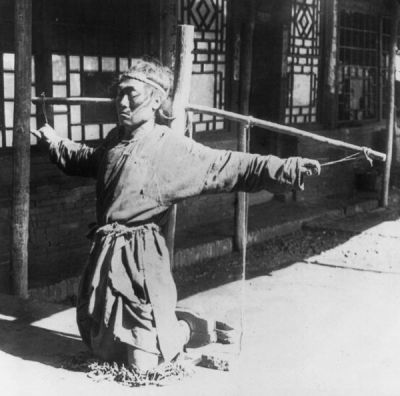
When the Jesuit missionaries came to Beijing in the early 17th century they were amazed at how low the crime rate was compared to back home in Europe. There was a good reason for this, China had developed a system of torture that frightened people into obeying the law. There was no real concept of defense, once arrested you were more or less condemned; a confession would be routinely extracted by torture (for example hanging by thumbs or kneeling on chains or crushing ankles). Your only real hope of acquittal would be the rapid intervention of influential family and friends.
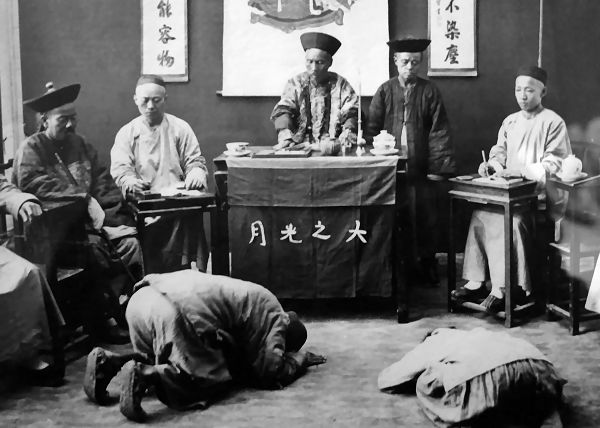
For most crimes the Imperial official (the magistrate) stood in judgment at his ‘yamen’. Each town would have a yamen which contained living accommodation, prison cells and the court room. There was no concept of defense or prosecution lawyers arguing the case and no jury system. Witnesses would give the evidence to the magistrate who would then pronounce his verdict. There were five categories of punishment: light beating, heavy beating, servitude, exile and death. Although there was an appeals system this was primarily used to challenge the category of crime rather than determine guilt or innocence. The ‘Doctor Dee’ series of crime novels set back in the Tang dynasty are based on the life of 狄仁杰 Dí Rénjié, a senior magistrate. His life was made popular by the books of Robert van Gulik ➚ and made into many films. They give a fairly accurate portrayal of the Chinese justice system at the time.
Death by a thousand cuts
The brutality of the system shocked Western visitors, for the top crimes the ultimate punishment was the 凌迟 Líng chí ‘death by a thousand cuts’ or ‘death by slow slicing’. This gruesome punishment followed a prescribed order starting with flaying off pieces of skin, muscles and then removal of body parts in order to maximize pain but keep the vital organs functioning. It ranged from 8 to 120 cuts – ‘death by numerous cuts’ is a better translation. This punishment was reserved for high treason (for example Zeng Jing ➚ and Hu Weiyong ➚) as well as the killing of a father or husband. The duty to parents was so strong in China that killing a parent was punished particularly severely. It was not only the culprit who suffered, his house was demolished, his teacher would be executed (obviously a bad influence!) as well as the local magistrate; even the provincial governor would often be demoted. If a husband killed his wife then the punishment was much less severe - often only a severe beating which reflects the much lower status of women in Imperial China.
One description of a 24 cut procedure is as follows:
1,2: Cut off eyebrows; 3,4: Cut off shoulder muscles; 5,6 : Muscles of the chest; 7,8: Muscles of lower arms; 9,10: Muscles of upper arms; 11,12: Muscles of thighs; 13,14: Muscles of calf; 15: Pierce the heart (and so death); 16: Decapitation; 17,18: Cut off hands; 19,20: Cut off arms; 21,22: Cut off feet; 23,24: Cut off legs.
The Ling chi punishment was available by Emperor’s decree from around 1000CE up until 1905. With such a gruesome punishment, another notch up from the British ‘hanged, drawn and quartered ➚’ (1238-1803), people must have thought twice or three times before committing such crimes. Often the Emperor would use his prerogative to be merciful by commuting the sentence to banishment to a remote province - by many considered still a death penalty as the majority would die in exile. It was also quite usual to lessen the punishment by paying appropriately large bribes.
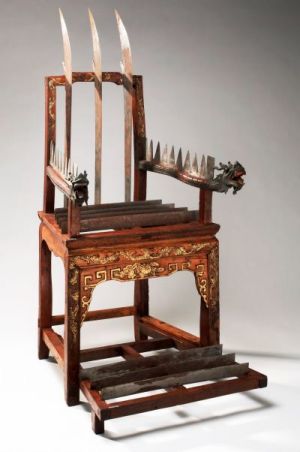
Legendary tortures
The tales of torture go back a long time in China. Perhaps the most evil reputation from early history is the story of Da Ji the seducer of the last Shang dynasty Emperor 帝辛 Dì xīn (c. 1050BCE). 妲己 Dá jǐ was considered a fox demon. The Emperor indulged her taste of the macabre. She is said to have wondered why a man could apparently walk over the frozen lake without apparent discomfort, so he had his feet cut off to investigate. She made similar gruesome investigations on pregnant women and how the heart functioned. She apparently liked to hear the screams of the tortured and devised the heated cauldron onto which victims were tied, slowly baking them to death. As history was written in the Zhou dynasty that succeeded the Shang such stories were probably circulated to discredit the last Shang loyalists.
An equally distressing story of torture concerns China's only Empress, Tang Empress Wu Zetian. Once again the story may have been concocted to discredit the rule of the dangerous precedent of a female ruler. She managed to depose Tang Emperor Gaozong (649-683)'s Empress (王玉燕 Wáng yù yān) and his favorite concubine (Consort Xiao). At first she had them imprisoned but when she believed the emperor became distressed at their treatment she had their hands and feet chopped off. They were then left to briefly live on as ‘pigs’. Empress Wang's dying curse was to be reincarnated as a cat and come to the palace and rip out Wu Zetian's throat. Consequently cats were banned from all the Imperial palaces.
Perhaps the acceptance of torture is in someway related to the belief in a Buddhist Hell. Rather like the visions of hell dreamed up by Dante ➚ the hell was full of different punishments considered appropriate for each misdemeanor. King Yan 阎王 Yánwáng is the god of death and ruler of hell who deals out the punishments. For example someone who steals or defaces a good book is flayed alive and someone who breaks up a marriage or engagement is impaled on spears. In Buddhism a malefactor is punished in hell for a few years before rebirth as some kind of creature.
Neck tower and other tortures
One slightly less sadistic method of execution was the neck tower. A prisoner is put inside a wooden box frame with the neck protruding and only stones to stand on. However each day a stone or two is removed so the poor prisoner dies slowly from strangulation.
A senior official in the imperial administration would dread the receipt of an imperial letter containing a piece of red silk as this had the clear meaning that the official was in severe disgrace and was expected to immediately hang or poison himself. Death by decapitation was considered a much more severe punishment as the Chinese believed it was important to keep the body intact to ensure the immortal spirit lived on after execution. So many would see death by hanging as much more merciful than death by beheading.

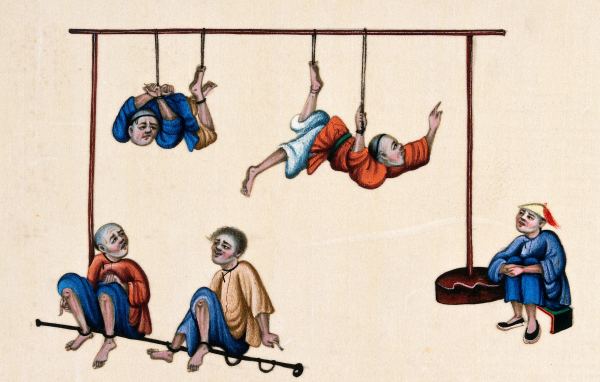

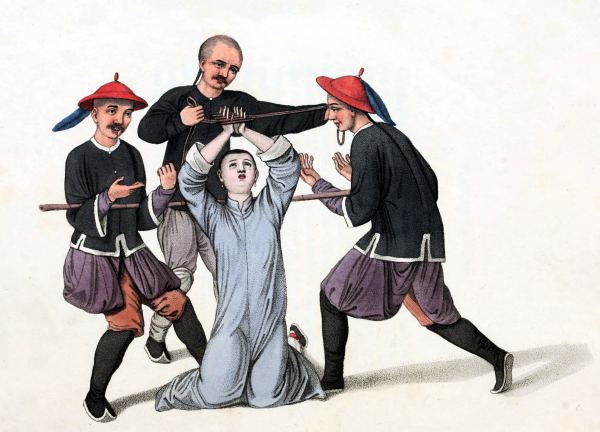
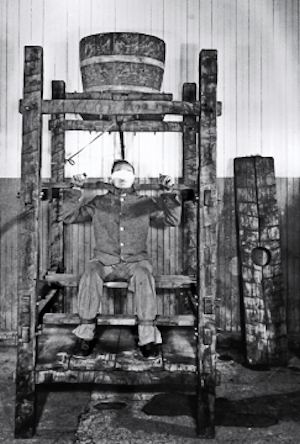
Slow drip torture
Perhaps a better known form of Chinese torture was the slow dropping of water onto the forehead with the body firmly strapped down. The incessant and regular dropping of water was a mental rather than physical torture, the victim never had any relief. If that wasn't enough there were occasions when acid was occasionally also dropped that would painfully burn through the skin into the brain. This increased the terror as the prisoner would not know if the next drop would be water or acid. Branding with hot irons and the amputation of limbs, genitals or the nose was widespread. Chopping off the nose (without anesthetic) was so common that it has own character in the language 劓 yì.
To ensure the extended family restrained all its members from criminal acts severe punishments were meted out to the whole lot. In extreme cases the whole male family would be executed miè zú (灭族) - grandfather, father, children, cousins and grandchildren. The most severe punished all relations within 'nine degrees' of relationship - including uncles, aunts and sisters-in-law. Family members under 16 years old and women would be spared but taken as slaves so the whole family would effectively 'disappear' from history. The worst example is probably from 1380 when Ming Emperor Hongwu charged Hu Weiyong ➚ with high treason. Not only was Hu's whole family slaughtered but anyone remotely associated with him, resulting in well over 30,000 executions - for one crime; although it should be said that this was probably more of a purge of possible dissidents rather than criminal punishment.
By comparison the case of Fāng Xìaorú ➚ 1357-1402 is less severe, he refused to acknowledge Emperor Yongle as the Emperor after a civil war with his nephew (the rightful heir). This so enraged the Emperor that the whole extended family of 873 members were slaughtered. This form of collective punishment was seen as important as families would collectively ensure there was no talk or even thought of treason. For lesser crimes the whole family would suffer through a drop in social esteem. The writer Lu Xun suffered along with his whole family because his grandfather had been found guilty of cheating at examinations.

Beatings and mobile stocks
The legal system had complex written rules with set punishments for all possible forms of crime (numbered in the thousands). For petty crimes it was common to put a wide wooden cangue ➚ around the neck for weeks or months, this prevented the convicts from being able to feed themselves or even sleep comfortably. It quite often led to death. The cangue had details of the crime pasted onto it for all to see. The weight of the cangue was determined by the severity of the crime. This is rather similar to stocks ➚ that were used in Europe. Some were punished by forced labor, for example pulling the royal barges on the Grand Canal for three years.
However most punishments were in the form of beatings with bamboo sticks. In the Yuan dynasty this was codified for a light stick (7 to 57 beatings in steps of 10) and with a heavy stick (67 -107 beatings). Death was common after heavy beatings - often due to infection setting in through the ruptured skin. So a beating of 100 heavy blows was treated as a death sentence. An appropriate bribe would normally be paid to lessen the force of the beatings and there was even an official scale of charges that would allow richer prisoners to escape the punishment altogether. By the Qing dynasty the number and severity of beatings was complex, for example if someone had been hit the punishment had a fixed scale according to the scale of injury caused: no obvious sign, bruise, broken skin or broken bones.
The Confucian doctrine of due deference was at the heart of the penal code. Attacks of a son against his father was one of the worst crimes. If a daughter attacked her parents causing injury she would be strangled to death. By the Qing dynasty the penal code had become very complex so a magistrate could simply look up the punishment without the need to determine it personally. The code took into account many factors for example if someone is murdered then vengeance was an accepted defense to lighten the sentence but vengeance had to be immediate and driven by rage and not cold calculation.
Effective deterrent
All these gruesome descriptions may give the impression of a brutal system but that was exactly what was intended. The legal system was one of fear and so rumors of the horror of torture proved a most effective deterrent. The Mongol invasion of China is remembered as a conquest by a particularly brutal people, and yet under their brief spell of rule the severity of punishments lessened. By the accounts of western visitors to China at the time the system of lurking threat worked well - they saw very little crime.
Modern times
The system of torture came to an official end with the foundation of the Republic in 1912 but hints remain to the present day. China still lacks an independent judiciary and so questioning a criminal charge continues to be seen as challenging the government that set the laws - making the culprit an enemy of the state. There are allegations that members of Falun Gong sect ➚ including Tang Yongjie and Gao Rongrong were tortured in a similar fashion to the ling chi. The centuries of threat of brutal punishment can still be seen have an impact on everyday life, Chinese people are reticent about committing themselves to a view or revealing their true opinion as in former years it could have had tragic repercussions.
China retains the death penalty (by lethal injection or gunshot). Although the number executed is a state secret, organizations estimate that thousands are executed each year, more than the rest of the world put together. The crimes with this punishment can be almost anything judged to be subversive from computer hacking to arson as well as rape and embezzlement.